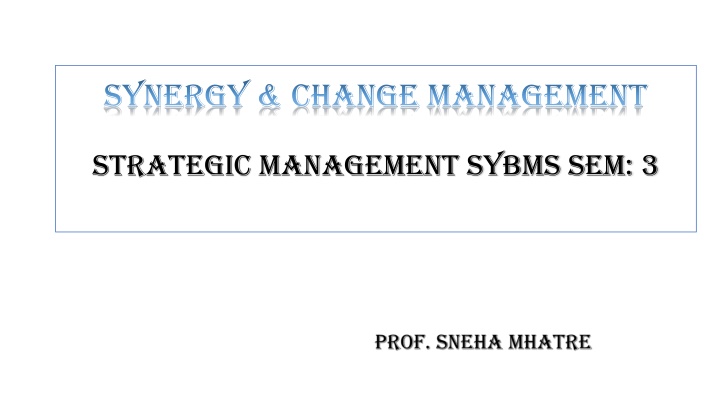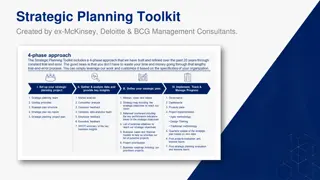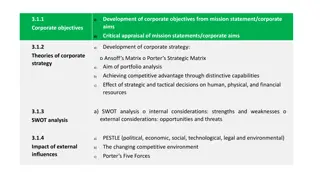
Synergy in Management: Definition, Types, and Evaluation
Explore the concept of synergy in management, how it relates to teamwork, its different types such as financial and operational synergy, and the importance of evaluating synergies in business, particularly in the context of mergers and acquisitions.
Uploaded on | 0 Views
Download Presentation

Please find below an Image/Link to download the presentation.
The content on the website is provided AS IS for your information and personal use only. It may not be sold, licensed, or shared on other websites without obtaining consent from the author. If you encounter any issues during the download, it is possible that the publisher has removed the file from their server.
You are allowed to download the files provided on this website for personal or commercial use, subject to the condition that they are used lawfully. All files are the property of their respective owners.
The content on the website is provided AS IS for your information and personal use only. It may not be sold, licensed, or shared on other websites without obtaining consent from the author.
E N D
Presentation Transcript
Synergy & change management Strategic Management SYBMS SEM: 3
Lets see what does synergy means Synergy in management and in relation to teamwork refers to the combined effort of individuals as participants of the team. The condition that exists when the organization's parts interact to produce a joint effect that is greater than the sum of the parts acting alone.
We can define Synergy as: Is two or more things working together in order to create something that is bigger or greater than the sum of their individual efforts
Different types of synergy Management Synergy Financials synergy Operational synergy Sales synergy Investment synergy
What do we mean by evaluation of synergy It is perceived by every management whether managing large or small business, Synergy is the concept that the combined values and performance of two companies will be greater than the sum of separate individuals. Synergy is a term that is most commonly used in the context of mergers and acquisitions. Evolution of synergies enables to reward marginal performance
Needs for evaluation of synergy Need for revaluation arises when the business fails to assess correctly the cost benefit of a potential synergy. In the mergers and acquisition the result of energy is far more encouraging. Regular evaluation of synergy gives managers alert all the time. Impact of external factors Importance if strategic control Importance of operational control Impact of internal factors Apprehensions in synergy Balanced view points Managerial biases
Synergy as a components OF strategy Synergy represent the value of the performance of two companies which when combined will be greater than the sum of the separate individual parts. Synergy increases productivity and output from the existing branches. Synergy is a component of strategy includes the following: Resource allocation Scope Goals Objectives Competitive advantage
Relevance of synergy To the business organisation Relevance of synergy To the society
To the business organisation To the society Systems approach Economic effect Group effect Competitive advantage Team synergy Positive environment Mergers and acquisitions Boost innovation Improved quality of life Optimum use of resources Social goods Revenue to government
Change management Nothing remains permanent in the landscape of management the only thing which is permanent is the change itself change has no beginning and no end. Strategic change management is the process of managing change in a structured, thoughtful way in order to meet organizational goals, objectives, and missions. In addition, strategic change managers use models to help move through the change process with purpose rather than haphazardly attempting to change the company.
Features of change management Ongoing process ( unavoidable ) Comprehensive in approach (dealing with every accepts) Reactive change (uncertain changes) Planned changes(predictions) Internal factors (administrations) External factors (outsiders) Change is not innovation ( getting things in different) Balancing act (smoothening) Explicit in nature (clearly expressed) Improves performance (survival)
Process of change management To identify the forces demanding changes. To identify need for changes. To diagnose the problem. To plan change (change in human resources, change in organisational structure & change in job design). To evaluate change forces (Driving forces, restraining forces). To implement the change plan (unfreezing, changing {compliance, identification & internalisation}, Refreezing ). Reviews & feedback
Resistance to change One of the most important facts of change management is resistance to change. It is simply human nature to counteract any changes and maintain the status quo. But since change is inevitable, instead of resisting changes the organization must try to implement them with minimum hassle. Resistance to change is the action taken by individuals and groups when they perceive that a change that is occurring as a threat to them. Key words here are 'perceive' and 'threat'. The threat need not be real or large for resistance to occur.
Factors effecting causes of resistance to change Factors Organisational Factors Individual factors Psychological Economic Social
Overcoming resistance to change 1. Resistance is a natural and inevitable except it. 2. Resistance does not always show its face: find it. 3. Resistance has many motivation: understand it 4. Degree with people's concern other than their arguments: confront it. 5. There is no one way to deal with resistance: manage it.
Suggestions for success in effecting change. Adequate preparation effective communication with employees training and guidance to employees employee preparation service to change agent cooperation from executives and other employees
Conclusions synergy Change management Change is never done alone. It takes the interactivity of every aspect of an organization (leaders, individual contributors, tools) to make change management successful. Gone are the days of five year plans. Synergy plays a key role in M&A contexts, both in the decision-making process and, subsequently, in the integration phase. However, despite the fact that synergy value is commonly regarded as one of the key success factors in M&A, research shows that firms generally fail to achieve the expected synergy.






















